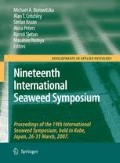Abstract
Aqueous extracts of Ascophyllum nodosum and several other brown seaweeds are manufactured commercially and widely distributed for use on agricultural crops. The increasingly regulated international trade in such products requires that they be standardized and defined to a degree not previously required. We examined commercially available extracts using quantitative 1H NMR and principal components analysis (PCA) techniques. Extracts manufactured over a 4-year period using the same process exhibited characteristic profiles that, on PCA, clustered as a discrete group distinct from the other commercial products examined. In addition to recognizing extracts made from different seaweeds, analysis of the 1H spectra in the 0.35–4.70 ppm region allowed us to distinguish amongst extracts produced from the same algal species by different manufacturers. This result established that the process used to make an extract is an important variable in defining its composition. A comparison of the 1H NMR integrals for the regions 1.0–3.0 ppm and 3.0–4.38 ppm revealed small but significant changes in the A. nodosum spectra that we attribute to seasonal variation in gross composition of the harvested seaweed. Such changes are reflected in the PCA scores plots and contribute to the scatter observed within the data point cluster observed for Acadian soluble extracts when all data are pooled. Quantitative analysis using 1H NMR (qNMR) with a certified external standard (caffeine) showed a linear relationship with extract concentration over at least an order of magnitude (2.5–33 mg/mL; R 2 > 0.97) for both spectral regions integrated. We conclude that qNMR can be used to profile (or “fingerprint”) commercial seaweed extracts and to quantify the amount of extract present relative to a suitably chosen standard.
Issued as NRCC no. 42,652.
Access this chapter
Tax calculation will be finalised at checkout
Purchases are for personal use only
Preview
Unable to display preview. Download preview PDF.
References
Ayad JY, Mahan JE, Allen VG, Brown CP (1997) Effect of seaweed extract and the endophyte in tall fescue on superoxide dismutase, glutathione reductase, and ascorbate peroxidase under varying levels of moisture stress. Proc Am Forage Grassland Council 6:173–177
Black WAP (1948) The seasonal variation in chemical composition of some of the littoral seaweeds common to Scotland. Part I. Ascophyllum nodosum. J Soc Chem Ind 67:355–357
Burton IW, Quilliam MA, Walter JA (2005) Quantitative 1H NMR with external standards: use in preparation of calibration solutions for algal toxins and other natural products. Anal Chem 77:3123–3131
Chapman VJ, Chapman DJ (1980) Seaweeds and their uses, 3rd edn. Chapman & Hall, London, pp 30–61
Craft CA, Hiltz D, Hankins S, MacKinnon SL (2007) Detection of plant growth hormones in Ascophyllum nodosum and seaweed products. MaNaPro XII Int Symp Mar Nat Products 12:PO74
Hiltz D, MacKinnon SL, Hankins S, Stefanova R, Craft CA (2007) Improved method of analysis of betaines in Ascophyllum nodosum and commercial seaweed. MaNaPro XII Int Symp Mar Nat Products 12:PO76
Jameson PE (1993) Plant hormones in the algae. Prog Phycol Res 9:239–279
Le Gall G, Colquhoun IJ, Davis AL, Collins GJ, Verhoeyen ME (2003) Metabolic profiling of tomato (Lycopersicon esculentum) using 1H NMR spectroscopy as a tool to detect potential unintended effects following a genetic modification. J Agric Food Chem 51:2447–2456
Milton RF (1952) Improvements in or relating to horticultural and agricultural fertilizers. British Patent 664,989
Newton L (1951) Seaweed utilization. Samson Low, London, pp 31–57
Niemela K, Sjostrom E (1985) Alkaline degradation of alginates to carboxylic acids. Carbohydr Res 144:241–249
Norrie J, Keathley JP (2006) Benefits of Ascophyllum nodosum marine-plant extract applications to ‘Thompson seedless’ grape production. Acta Hortic 727:243–245
Patier P, Yvin J-C, Kloareg B, Lienart Y, Rochas C (1993) Seaweed liquid fertilizer from Ascophyllum nodosum contains elicitors of plant D-glycanases. J Appl Phycol 5:343–349
Pauli GF, Jaki B, Lankin D (2005) Quantitative 1H NMR: development and potential of a method for natural products analysis. J Nat Prod 68:133–149
Pauli GF, Jaki BU, Lankin DC, Walter JA, Burton IW (2007) Quantitative NMR of bioactive natural products. In: Colgate SM, Molyneaux RJ (eds) Bioactive natural products: detection, isolation and structural determination. CRC, Boca Raton, in press
Penkala L (1912) Method of treating seaweed. British Patent 27,257
Radwan A, Davies G, Fataftah A, Ghabbour EA, Jansen SA, Willey RJ (1997) Isolation of humic acid from the brown algae Ascophyllum nodosum, Fucus vesiculosus, Laminaria saccharina and the angiosperm Zostera marina. J Appl Phycol 8:553–562
Senn TL, Kingman AR (1978) Seaweed research in crop production 1958-1978. Project no. 99-6-09329-2. Economic Development Administration, US Department of Commerce, Washington DC
Stephenson WA (1974) Seaweed in agriculture & horticulture, 3rd edn. Barglya & Gylver Rateaver, Pauma Valley, CA
Stirk WA, van Staden J (2006) Seaweed products as biostimulants in agriculture. In: Critchley AT, Ohno M, Largo DB (eds) World seaweed resources: an authoritative reference system. A multimedia, interactive DVD ROM. ETI Bioinformatics, Amsterdam
Tojo E, Prado J (2003) A simple 1H NMR method for the quantification of carrageenans in blends. Carbohydr Polym 53:325–329
Van de Velde F, Knutsen SH, Usov AI, Rollema HS, Cerezo AS (2002) 1H and 13C high resolution NMR spectroscopy of carrageenans: application in research and industry. Trends Food Sci Technol 13:73–92
Verkleij FN (1992) Seaweed extracts in agriculture and horticulture: a review. Biol Agric Hort 8:309–324
Author information
Authors and Affiliations
Corresponding author
Editor information
Editors and Affiliations
Rights and permissions
Copyright information
© 2007 Springer Science + Business Media B.V.
About this chapter
Cite this chapter
Craigie, J.S., MacKinnon, S.L., Walter, J.A. (2007). Liquid seaweed extracts identified using 1H NMR profiles. In: Borowitzka, M.A., Critchley, A.T., Kraan, S., Peters, A., Sjøtun, K., Notoya, M. (eds) Nineteenth International Seaweed Symposium. Developments in Applied Phycology, vol 2. Springer, Dordrecht. https://doi.org/10.1007/978-1-4020-9619-8_27
Download citation
DOI: https://doi.org/10.1007/978-1-4020-9619-8_27
Received:
Revised:
Accepted:
Publisher Name: Springer, Dordrecht
Print ISBN: 978-1-4020-9618-1
Online ISBN: 978-1-4020-9619-8
eBook Packages: Biomedical and Life SciencesBiomedical and Life Sciences (R0)

